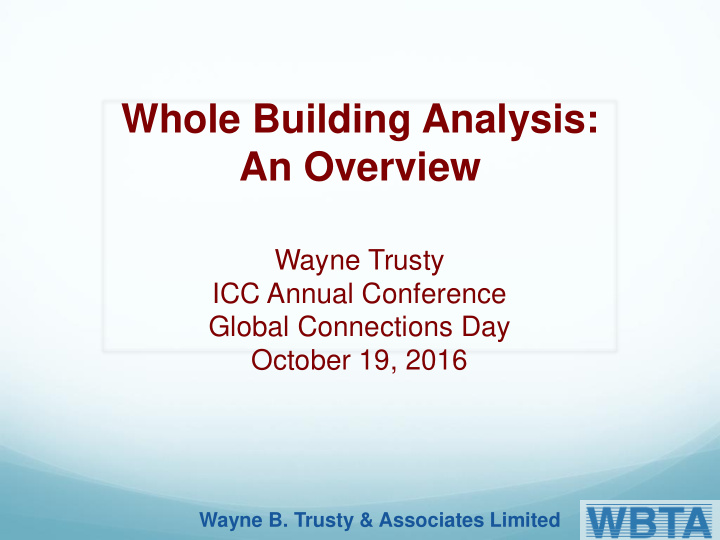



Whole Building Analysis: An Overview Wayne Trusty ICC Annual Conference Global Connections Day October 19, 2016 Wayne B. Trusty & Associates Limited
transportation water use energy use Life Cycle resource resource use extraction Assessment (depletion) effects emissions to water emissions to air solid wastes A methodology for assessing the environmental performance of a product over its full life cycle
Whole building LCA in NA codes, standards and rating systems
Terminology Environmental Effects Cradle - to - gate (Manufacturing) Initial embodied On-site construction Recurring embodied Operations & Maintenance + (Occupancy) Operating End - of - Life Final Embodied
Tracking Flows: The Inventory Step MATERIAL ACQUISITION Raw Material Acquisition Manufacturing Emissions Material to: resources Products / Assemblies BUILDING CONSTRUCTION Air (manufacturing) Energy OCCUPANCY Water (use, reuse, maintenance) Land DEMOLITION/DISPOSAL Water Products / Materials Recycle / Reuse Waste Management
Impact Assessment Phase Inventory • global warming potential • ozone depletion potential • acidification potential (characterization • eutrophication potential & Mid-point impact indicators Normalization) • fossil fuel use • material resource use (renewable & non-renewable) • water use • waste (hazardous and non-hazardous) Impact Assessment (Valuation) THE GOAL: to measure ultimate impacts on human and ecosystem health
Whole building LCA tool kit – examples Some LCA tools connect to BIM tools like Revit
Picking the right tool
Standard Practice for Minimum Criteria for Comparing Whole Building Life Cycle Assessments for Use with Building Codes, Standards, and Rating Systems Supports use of whole building LCA in codes, standards, and building rating systems Ensure comparative assessments of final designs relative to reference designs of the same building are fair and take account of: • Relevant building features • Life cycle stages and related activities • Building service life and product maintenance/replacements • Etc.
Existing Buildings
LCA-based Avoided Impacts Approach It does not matter what the existing building is made of It ’ s what the replacement is made of that matters We avoid impacts of demolishing the old and building new We incur impacts from renovation Must pay attention to operating effects, especially energy
LCA Limitations LCA is not the answer to all problems E.g., does not readily handle such issues as: Indoor environmental quality Uncertainty and risk related to toxic releases Site specific resource extraction effects Biodiversity Think in terms of a toolkit & don’t expect one tool to do it all
In Conclusion: LCA let you ... Take the environment into account throughout the project delivery process Focus on true environmental performance measures Look at the entire life cycle of a building Make functionally equivalent material comparisons Recognize and take account of environmental and economic trade-offs Make sound decisions about whether to keep or demolish existing buildings A FINAL CAUTION: BE WARY OF SIMPLISTIC ANSWERS TO COMPLEX QUESTIONS
Thank you . . .
In the Case of Energy… Even source energy doesn’t get it all End use energy estimates just one part of the story The rest of the story is the energy to make and move energy — called pre- combustion in LCA
Design 1 Design 2 Regional Electricity Grids INVENTORY Transportation & Product Technologies Maintenance Schedules u Raw Materials u Energy Use by type u Water Use Building Bill of Materials u Emissions to Air Assemblies u Emission to Water u Solid Wastes Life Cycle Inventories Materials & Products SUMMARY MEASURES Energy pre- combustion Building Construction u Primary energy effects u Acidification Operations u Aquatic eutrophication Demolition/ Disposal u Global warming potential u Respiratory effects u Ozone depletion u Resource use u Photochemical smog . . . informed environmental choices
The ISO 14040/44 Framework Life Cycle Assessment Framework Direct Applications Goal & Scope • Product Development Definition & Improvement • Strategic planning Inventory • Public policy making Interpretation Analysis (LCI) • Marketing • Transparency Impact Assessment (LCIA)
Recommend
More recommend